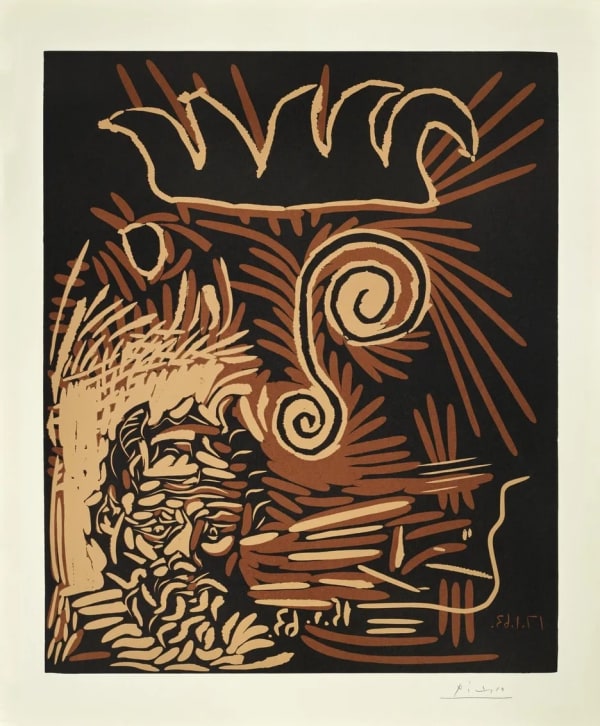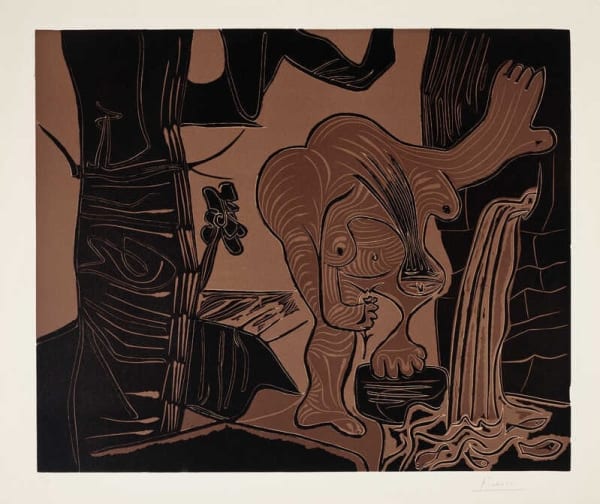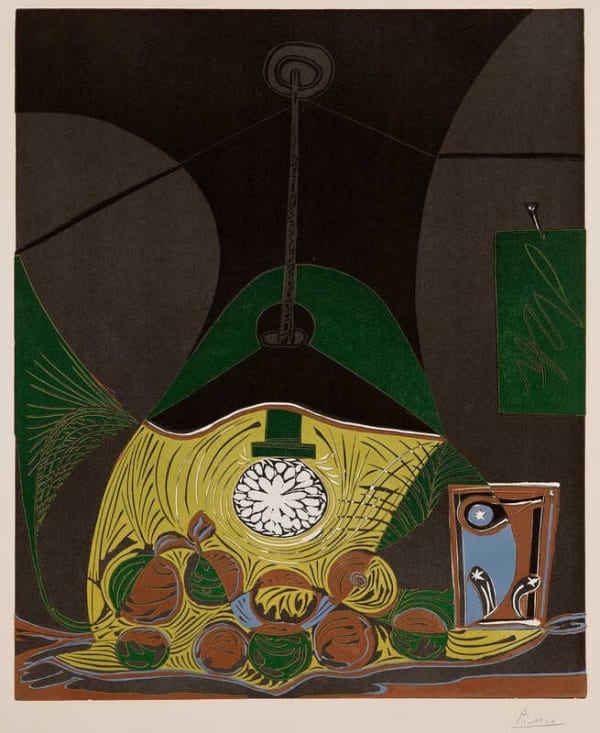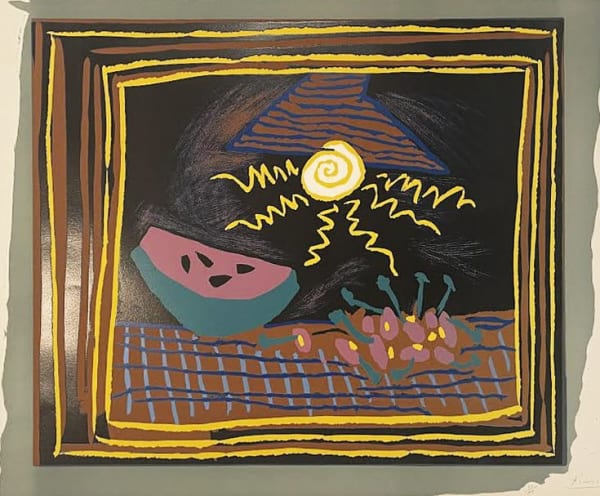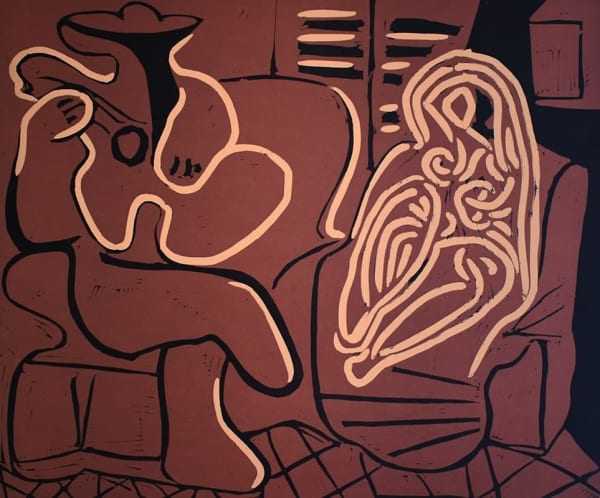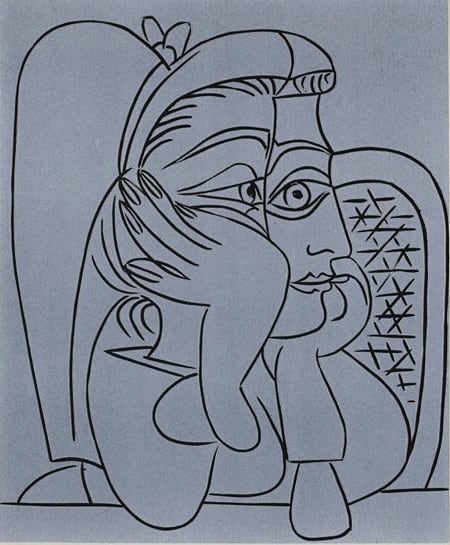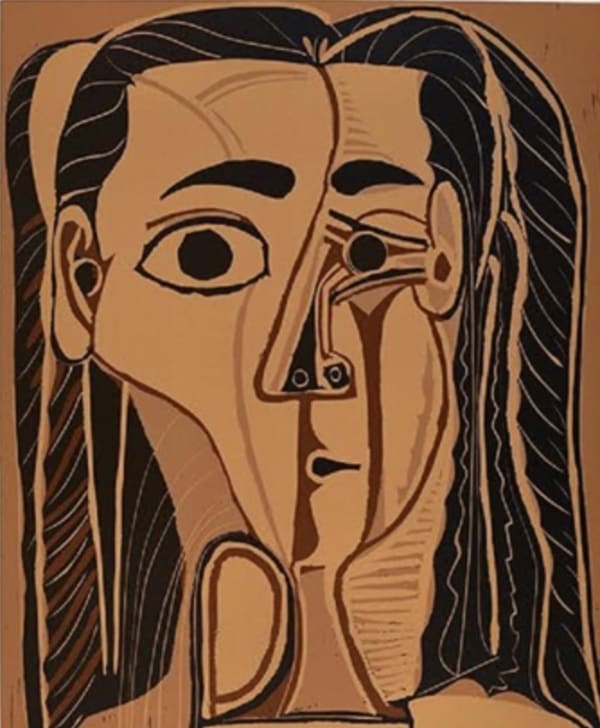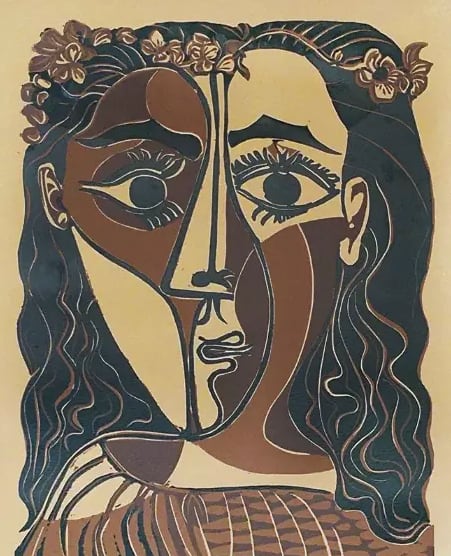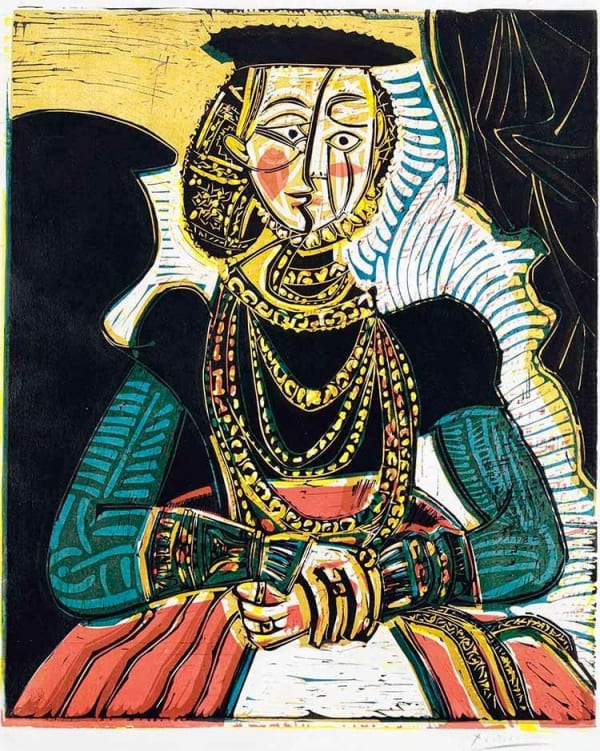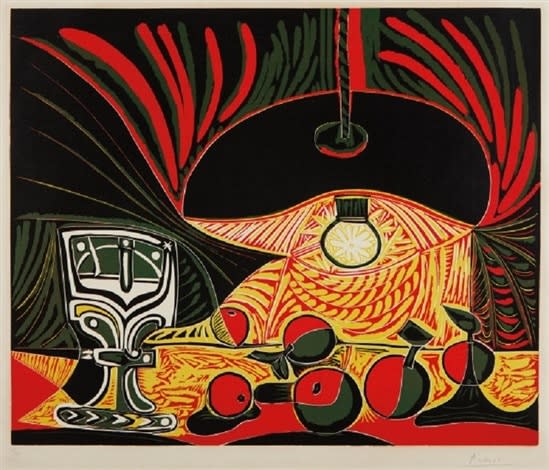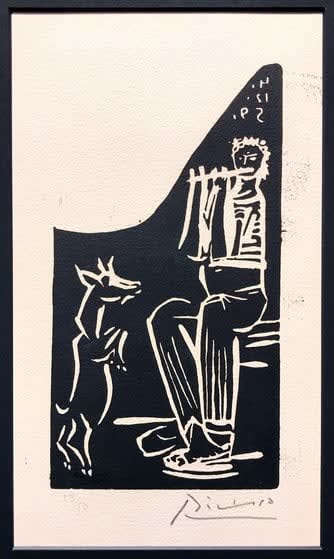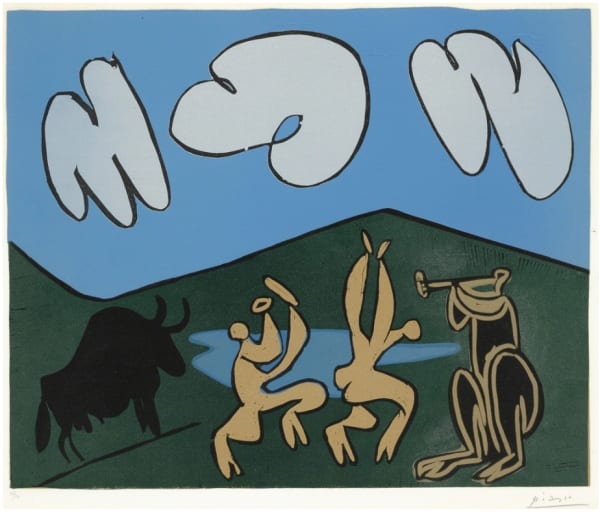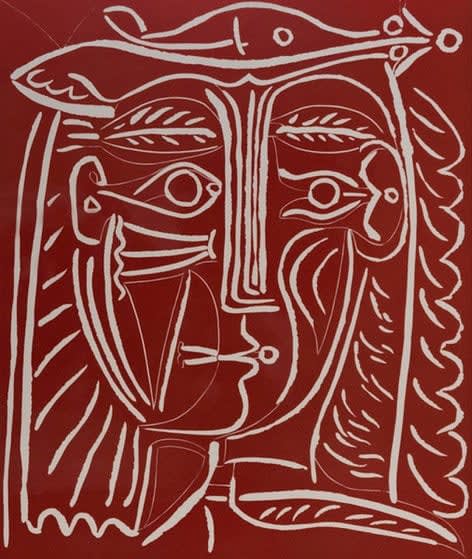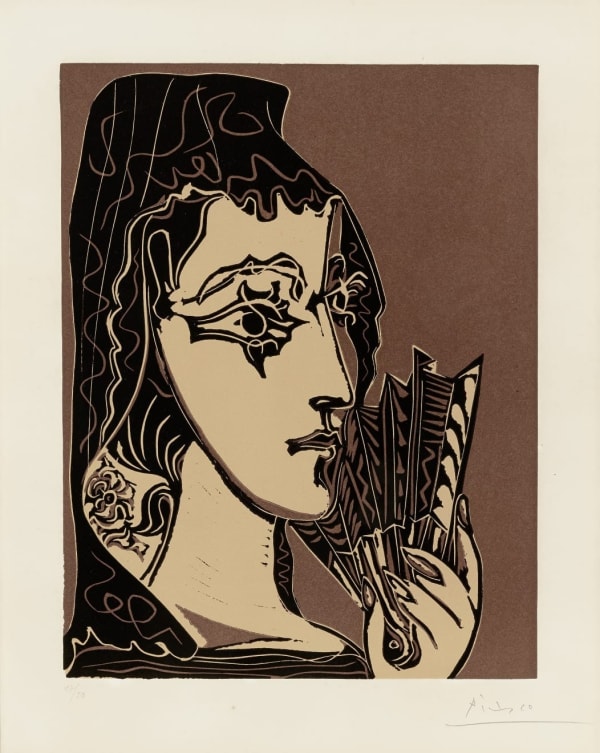
Pablo Picasso
Signed in Pencil
53.1 x 64.5 cm
This 1959 linocut by Pablo Picasso, Deux Femmes près de la Fenêtre, is a striking demonstration of his late printmaking mastery, where the linocut became one of his boldest and most experimental mediums. Executed with reduction techniques and printed in earthy tones of black and terracotta, the work captures the intimacy of an interior scene while transforming it into a monumental composition of rhythm, contrast, and abstraction.
Picasso, working in Vallauris alongside printer Hidalgo Arnéra, revolutionized the linocut medium during the 1950s. Instead of using multiple blocks for different colors, he perfected the reduction method—cutting and re-cutting a single block in successive stages, each layer of carving permanently altering the plate. This demanding process required extraordinary precision and confidence, since earlier stages could not be revised once removed.
In Deux Femmes près de la Fenêtre, the result is a masterclass in tonal layering. The earthy reds and deep blacks are balanced by lighter beige highlights, producing depth and atmosphere without sacrificing the flat, graphic clarity inherent to linocut. The medium’s bold contrasts reinforce the solidity of the figures while creating a dramatic interplay between shadow and light.
The composition presents two women seated near a window, a subject that recalls both Picasso’s earlier Cubist interiors and his Neoclassical figures of the 1920s. The woman in the foreground is depicted with bold striations carved into her body, emphasizing musculature, texture, and expressive dynamism. By contrast, the second woman, seated more upright and further back, is rendered in simplified contour, her silhouette serene and monumental.
This juxtaposition of figures—one dynamic, almost sculptural, the other calm and statuesque—creates a dialogue of contrasts: movement versus stillness, flesh versus outline, sensual immediacy versus idealized presence. The window to the right serves as a framing device, suggesting both domestic intimacy and the metaphor of looking outward, a theme Picasso often explored in his depictions of women.
The work epitomizes Picasso’s mastery of the linocut process, showcasing his ability to create both texture and volume through reduction carving. The intricate striations on the reclining figure highlight his technical ingenuity—using the carving knife almost like a brush to create rhythmic patterns of light and shadow. Meanwhile, the bold silhouettes of the seated woman and draped textiles demonstrate his economy of means, where simple shapes achieve monumental weight.
This duality between fine detail and sweeping simplicity is one of Picasso’s greatest achievements in the medium. Unlike the delicate tonal subtleties of his lithographs or the layered densities of his etchings, his linocuts are unapologetically graphic, relying on contrast and clarity to achieve their power.
The theme of women near windows runs throughout Picasso’s oeuvre, from his Cubist works of the 1910s to his postwar paintings. The motif symbolizes both interior intimacy and the act of looking—women as muses, as companions, and as subjects of contemplation. In the context of the 1950s, when Picasso was working prolifically in printmaking, ceramics, and painting, such works also underscore his continued interest in domestic and sensual themes, translated here into the boldest graphic language.
Deux Femmes près de la Fenêtre (1959) exemplifies Picasso’s late linocut style: monumental, graphic, and experimental. Through the reduction method, he creates a dynamic interplay of tonal contrasts, textures, and forms that convey both intimacy and grandeur. The work not only reaffirms his technical mastery but also his ability to continually reinvent traditional themes—such as women by a window—through new mediums and visual languages.
It stands as a testament to how, even in his later years, Picasso remained at the forefront of innovation, pushing linocut to its expressive limits and transforming a simple domestic subject into a timeless, modern icon.
For more information or to buy Deux Femmes près de la Fenêtre by Pablo Picasso, contact our galleries using the form below.-
 Pablo PicassoTwo Women by the Window | Deux femmes près de la fenêtre, 1959
Pablo PicassoTwo Women by the Window | Deux femmes près de la fenêtre, 1959 -
 Pablo PicassoWoman Reclining and Man with a Guitar | Femme couchée et homme à la guitare, , 1959
Pablo PicassoWoman Reclining and Man with a Guitar | Femme couchée et homme à la guitare, , 1959 -
 Pablo PicassoJacqueline au chapeau de paille, 1962
Pablo PicassoJacqueline au chapeau de paille, 1962 -
 Pablo PicassoLe Vieux bouffon, 1963
Pablo PicassoLe Vieux bouffon, 1963 -
 Pablo PicassoHomme au batôn / Le Vieux bouffon, 1963
Pablo PicassoHomme au batôn / Le Vieux bouffon, 1963 -
 Pablo PicassoFemme nue à la source, 1963
Pablo PicassoFemme nue à la source, 1963 -
 Pablo PicassoNature morte à la suspension, 26 mars, 1962
Pablo PicassoNature morte à la suspension, 26 mars, 1962 -
 Pablo PicassoTaureau et Picador, 1959
Pablo PicassoTaureau et Picador, 1959 -
 Pablo PicassoFemme au Chapeau (Portrait de Jacqueline au chapeau de paille multicolore)., 1962
Pablo PicassoFemme au Chapeau (Portrait de Jacqueline au chapeau de paille multicolore)., 1962 -
 Pablo PicassoLe Déjeuner sur l'herbe d'aprés Edouard Manet. (The Luncheon on the Grass after Edouard Manet), 1954
Pablo PicassoLe Déjeuner sur l'herbe d'aprés Edouard Manet. (The Luncheon on the Grass after Edouard Manet), 1954 -
 Pablo PicassoBoy with a Crown of Leaves | Jeune homme couronné de feuillage, 1959
Pablo PicassoBoy with a Crown of Leaves | Jeune homme couronné de feuillage, 1959 -
 Pablo PicassoLe Vieux Roi (B. 1152) (The Old King) , 1963
Pablo PicassoLe Vieux Roi (B. 1152) (The Old King) , 1963 -
 Pablo PicassoNature Morte a la Pasteque, 1962
Pablo PicassoNature Morte a la Pasteque, 1962 -
 Pablo PicassoAubade, with a Woman in an Armchair | L'aubade, avec femme dans un fauteuil, 1959
Pablo PicassoAubade, with a Woman in an Armchair | L'aubade, avec femme dans un fauteuil, 1959 -
 Pablo PicassoL'Aubade, avec Femme Accoudee, 1959
Pablo PicassoL'Aubade, avec Femme Accoudee, 1959 -
 Pablo PicassoLes vendangeurs, 1959
Pablo PicassoLes vendangeurs, 1959 -
 Pablo PicassoFemme Accoudée (Bloch 922) , 1959
Pablo PicassoFemme Accoudée (Bloch 922) , 1959 -
 Pablo PicassoGrande Tete De Femme (Bloch 1069), 1962
Pablo PicassoGrande Tete De Femme (Bloch 1069), 1962 -
 Pablo PicassoPetite Tête de Femme Couronnée, `962
Pablo PicassoPetite Tête de Femme Couronnée, `962 -
 Pablo PicassoBuste de Femme d'après Cranach le Jeune, (Bloch 859), 1958
Pablo PicassoBuste de Femme d'après Cranach le Jeune, (Bloch 859), 1958 -
 Pablo PicassoPortrait de Jacqueline Accoudée, 1959
Pablo PicassoPortrait de Jacqueline Accoudée, 1959 -
 Pablo PicassoJacqueline au Bandeau, 1962
Pablo PicassoJacqueline au Bandeau, 1962 -
 Pablo PicassoNature Morte Au Verre Sous La Lampe, 1962
Pablo PicassoNature Morte Au Verre Sous La Lampe, 1962 -
 Pablo PicassoPortrait de Jacqueline Au Chapeau De Paille Fleuri, 1962
Pablo PicassoPortrait de Jacqueline Au Chapeau De Paille Fleuri, 1962 -
 Pablo PicassoLa Pique en Rouge et Jaune (The Bullfight in Red and Yellow), 1959
Pablo PicassoLa Pique en Rouge et Jaune (The Bullfight in Red and Yellow), 1959 -
 Pablo PicassoNu Assis, 1962
Pablo PicassoNu Assis, 1962 -
 Pablo PicassoPortrait De Jacqueline (Bloch 923), 1959
Pablo PicassoPortrait De Jacqueline (Bloch 923), 1959 -
 Pablo PicassoPortrait de Femme a la Fraise et au Chapeau , 1962
Pablo PicassoPortrait de Femme a la Fraise et au Chapeau , 1962 -
 Pablo PicassoL'Etreinte (Bloch 1150), 1963
Pablo PicassoL'Etreinte (Bloch 1150), 1963 -
 Pablo PicassoFaune et Chévre, 1959
Pablo PicassoFaune et Chévre, 1959 -
 Pablo PicassoBacchanale au Taureau Noir (Bloch 935), 1959
Pablo PicassoBacchanale au Taureau Noir (Bloch 935), 1959 -
 Pablo PicassoTête de Femme au Chapeau , 1962
Pablo PicassoTête de Femme au Chapeau , 1962 -
 Pablo PicassoJacqueline au Bandeau, 1962
Pablo PicassoJacqueline au Bandeau, 1962 -
 Pablo PicassoWatermelon Still Life, 1962
Pablo PicassoWatermelon Still Life, 1962 -
 Pablo PicassoBacchanale au Hibou (bloch 938), 1959
Pablo PicassoBacchanale au Hibou (bloch 938), 1959 -
 Pablo PicassoPortrait de Jacqueline en Carmen (L'Espagnole) , 1962
Pablo PicassoPortrait de Jacqueline en Carmen (L'Espagnole) , 1962
Join our mailing list
* denotes required fields
We will process the personal data you have supplied in accordance with our privacy policy (available on request). You can unsubscribe or change your preferences at any time by clicking the link in our emails.
This website uses cookies
This site uses cookies to help make it more useful to you. Find out more about cookies.



